Hafnium isotopic disequilibrium during sediment melting and assimilation
Affiliations | Corresponding Author | Cite as | Funding information- Share this article





Article views:2,169Cumulative count of HTML views and PDF downloads.
- Download Citation
- Rights & Permissions
top
Abstract
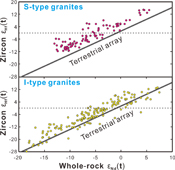
Figures and Tables
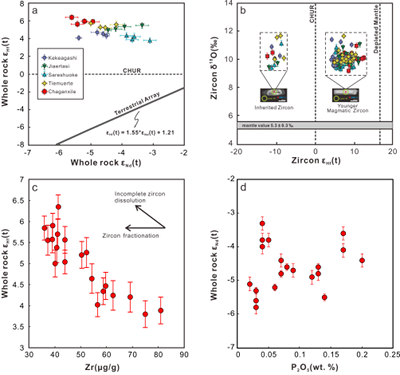 Figure 1 (a) εHf(t) versus εNd(t) for SPG in the Chinese Altai calculated based on U-Pb ages of the various plutons. Terrestrial array equations are from Vervoort et al. (2011). (b) Zircon εHf(t) versus zircon δ18O for SPG in the Chinese Altai. Mantle values after Valley et al. (1998). Inherited zircons show εHf(t) and δ18O values, indicating a metasedimentary source. Younger magmatic zircons show positive εHf(t) values and similarly high δ18O values, CHUR-chondritic uniform reservoir. (c) εHf(t) versus Zr (µg/g). (d) εNd(t) versus P2O5 (wt. %). Uncertainties of all isotope measurements are internal 2σ. | 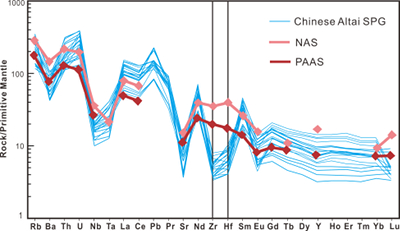 Figure 2 Primitive mantle-normalised trace element spider patterns of the studied granites, PAAS and NAS. Normalisation data from Sun and McDonough (1989). Note the Zr-Hf depletions of the SPG from this study. All the data are listed in Table S-4. | 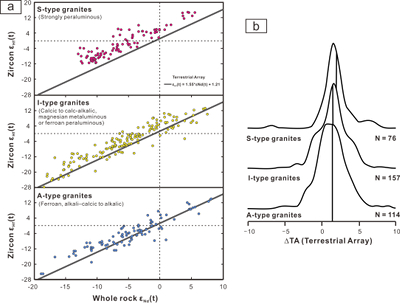 Figure 3 (a) Compilation of published neodymium and hafnium isotopic compositions of I-type, A-type, and S-type granites (as defined in the figure). Points represent average zircon values from single plutons. References listed in Table S-3. (b) Distance from the terrestrial array (TA) expressed as ΔTA calculated for the three granite groups. Vertical line represents the median of all of the samples and demonstrate an increasing shift towards greater Hf disequilibrium (above the TA) with increasing aluminousity. | 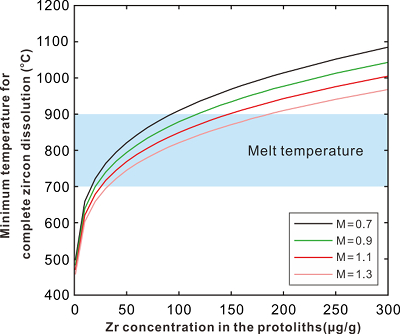 Figure 4 Calculated minimum melt temperature for zircon dissolution as a function of Zr concentration in the protoliths and M value (cation ratio). SPG have M values > 1.1 while I-type granites typically have M values < 1.0. Melt Zr concentration at zircon saturation using the zircon saturation model of Boehnke et al. (2013). |
| Figure 1 | Figure 2 | Figure 3 | Figure 4 |
Introduction
Strongly-peraluminous granites (SPG) generally indicate that partial melting of metasedimentary crustal rocks has been occurring throughout Earth’s history (Harris et al., 2000
Harris, N., Vance, D., Ayres, M. (2000) From sediment to granite: timescales of anatexis in the upper crust. Chemical Geology 162, 155-167.
; Appleby et al., 2010Appleby, S.K., Gillespie, M.R., Graham, C.M., Hinton, R.W., Oliver, G.J.H., Kelly, N.M. (2010) Do S-type granites commonly sample infracrustal sources? New results from an integrated O, U–Pb and Hf isotope study of zircon. Contributions to Mineralogy and Petrology 160, 115–132.
; Bucholz and Spencer, 2019Bucholz, C.E., Spencer, C.J. (2019) Strongly peraluminous granites across the Archean-Proterozoic transition. Journal of Petrology 60, 1299–1348.
). Experimental and geodynamic modelling have been applied to understanding the chemistry and physics of partial melting processes (Sawyer et al., 1991Sawyer, E.W. (1991) Disequilibrium melting and the rate of melt–residuum separation during migmatization of mafic rocks from the Grenville Front, Quebec. Journal of Petrology 32, 701–738.
, 2011Sawyer, E.W., Cesare, B., Brown, M. (2011) When the Continental Crust Melts. Elements 7, 229–234.
). It is assumed that crustal partial melts inherit the radiogenic isotope composition of their protoliths. Hafnium (Hf) is a geochemically important element in zircon because its isotopic composition is a sensitive tracer of crustal and mantle processes (Kemp et al., 2006Kemp, A.I.S., Hawkesworth, C.J., Paterson, B.A., Kinny, P.D. (2006) Episodic growth of the Gondwana supercontinent from hafnium and oxygen isotopes in zircon. Nature 439, 580.
). Zircon retains the initial melt isotopic composition because of its low Lu/Hf ratio and refractory nature in sedimentary processes (Andersen et al., 2002Andersen, T. (2002) Correction of common lead in U–Pb analyses that do not report 204Pb. Chemical Geology 192, 59–79.
). However, studies of SPG have shown the Hf isotopic composition of partial melts may not match the inferred magma source (Belousova et al., 2005Belousova, E.A., Griffin, W.L., O'Reilly, S.Y. (2005) Zircon crystal morphology, trace element signatures and Hf isotope composition as a tool for petrogenetic modelling: examples from Eastern Australian granitoids. Journal of Petrology 47, 329–353.
; Villaros et al., 2012Villaros, A., Buick, I.S., Stevens, G. (2012) Isotopic variations in S-type granites: an inheritance from a heterogeneous source? Contributions to Mineralogy and Petrology 163, 243-257.
; Iles et al., 2019Iles, K.A., Hergt, J.M., Woodhead, J.D. (2019) Petrogenesis of granitoids from the Lachlan Fold Belt, southeastern Australia: the role of disequilibrium melting. Gondwana Research https://doi.org/10.1016/j.gr.2019.08.011.
). Residual zircons, i.e. not dissolved during partial melting, may retain a significant amount of unradiogenic Hf (i.e. low 176Hf/177Hf) causing the derivative crustal melts to have higher 176Hf/177Hf ratios relative to the bulk source (Farina et al., 2014Farina, F., Stevens, G., Gerdes, A., Frei, D. (2014) Small-scale Hf isotopic variability in the Peninsula pluton (South Africa): the processes that control inheritance of source 176Hf/177Hf diversity in S-type granites. Contributions to Mineralogy and Petrology 168, 1065.
). In such cases, source composition and melting conditions exert a first order control on Hf isotopic equilibrium during anatexis (Tang et al., 2014Tang, M., Wang, X.L., Shu, X.J., Wang, D., Yang, T., Gopon, P. (2014) Hafnium isotopic heterogeneity in zircons from granitic rocks: Geochemical evaluation and modeling of “zircon effect” in crustal anataxis. Earth and Planetary Science Letters 389, 188–199.
). To test the residual zircon effect on Hf isotopes in granitic rocks, we carried out a Nd-Hf-O isotopic study of SPG in the Chinese Altai. We then evaluate the generality of residual zircon effect in granitic magmatism using a compiled Nd-Hf isotope database.The Central Asian Orogenic Belt (CAOB) is Earth’s largest Phanerozoic accretionary orogen (Kröner et al., 2014
Kröner, A., Kovach, V., Belousova, E., Hegner, E., Armstrong, R., Dolgopolova, A., Seltmann, R., Alexeiev, D.V., Hoffmann, J.E., Wong, J., Sun, M., Cai, K., Wang, T., Tong, Y., Wilde, S.A., Degtyarev, K.E., Rytsk, E. (2014) Reassessment of continental growth during the accretionary history of the Central Asian Orogenic Belt. Gondwana Research 25, 103–125.
). The Chinese Altai is located in the central CAOB (Fig. S-1a), with >40 % of the exposed rocks being granites (Zhang et al., 2017Zhang, C., Liu, L.F., Santosh, M., Luo, Q., Zhang, X. (2017) Sediment recycling and crustal growth in the Central Asian Orogenic Belt: Evidence from Sr–Nd–Hf isotopes and trace elements in granitoids of the Chinese Altay. Gondwana Research 47, 131–141.
). Previous studies dated CAOB plutons as Late Ordovician-Devonian (450 to 370 Ma) and Permian (280 to 270 Ma) and also report Nd-Hf isotopic decoupling in these granites (e.g., Zhang et al., 2017Zhang, C., Liu, L.F., Santosh, M., Luo, Q., Zhang, X. (2017) Sediment recycling and crustal growth in the Central Asian Orogenic Belt: Evidence from Sr–Nd–Hf isotopes and trace elements in granitoids of the Chinese Altay. Gondwana Research 47, 131–141.
). This paper reports new U-Pb ages, Nd-Hf-O isotopic compositions, major and trace element geochemistry, and Hf-O isotopes of inherited zircons within SPG samples from the Chinese Altai with the aim of providing insights into SPG melting processes and isotope systematics.top
Methods and Results
Granite samples from the Kekeagashi, Tiemuerte, Jiaertasi, Chaganxile, and Sareshuoke plutons in the Chinese Altai (Fig. S-1b) were analysed. In situ zircon U-Pb analysis was performed using laser ablation inductively coupled plasma mass spectrometry (ICP-MS). Whole rock (WR) major/trace element compositions were analysed using X-ray fluorescence spectrometry and inductively coupled plasma mass spectrometry. Nd isotope measurements were conducted using a MAT-262 thermal ionisation mass spectrometer in static mode. Hf isotope measurements were analysed using Nu Plasma II ICP-MS. In situ zircon Hf isotope analyses were conducted using a Thermo Scientific Neptune ICP-MS coupled to a 193-nm laser. In situ zircon O isotope analyses were conducted using a Cameca IMS-1280HR secondary ion mass spectrometer. Details of analytical methods are provided in Supplementary Information.
Zircon U-Pb ages show granite crystallisation between 437 and 409 Ma (Fig. S-2). U-Pb dating of inherited zircon cores indicate that Palaeozoic zircon grains seeded on significantly older crystals, with ages ranging from 3506 to 1990 Ma (Fig. S-3). The WR ɛNd(t) and ɛHf(t) values range from −5.6 to −3.1 and +3.8 to +6.3, respectively. The δ18O and ɛHf(t) values of the magmatic zircon rims spanned from +9.2 to +11.6 ‰ and +4.0 to +12.3, respectively. The δ18O values of zircon cores range from +9.3 to +11.8 ‰ and ɛHf(t) values from −12.4 to −8.2. Data are available in Tables S-1 and S-2.
top
Discussion and Implications
High δ18O values (+9.2 to +11.6 ‰), low εNd(t) values (−5.6 to −3.1), strongly-peraluminous character (A/CNK = 1.1-1.3), presence of aluminous minerals (i.e. garnet, sillimanite, cordierite, and muscovite; Fig. S-4), and low Fe, Mg, Ca, and Na contents are consistent with derivation of melted sediment (Chappell and White, 1974
Chappell, B., White, A. (1974) Two contrasting granite types. Pacific Geology 8, 173–174.
).The highly radiogenic Hf isotopes of these SPG and Nd-Hf isotopic decoupling (Fig. 1a) give contradictory implications as to the contributions of isotopically depleted and enriched materials. It is feasible that Nd-Hf isotopic decoupling is either highlighting differential source signature or caused by crustal melting processes. Mineral sorting effects during sediment transport can concentrate zircon in coarse-grained sedimentary rocks while fine-grained, clay-rich rocks are nearly devoid of zircon (Carpentier et al., 2009
Carpentier, M., Chauvel, C., Maury, R.C., Mattielli, N. (2009) The “zircon effect” as recorded by the chemical and Hf isotopic compositions of Lesser Antilles forearc sediments. Earth and Planetary Science Letters 287, 86–99.
). Consequently, zircon-depleted sediments tend towards radiogenic Hf isotope signatures, while zircon-rich sediments generally have unradiogenic Hf isotope compositions. Melting of fine-grained, zircon-poor sedimentary rocks is likely to produce magmas with radiogenic Hf isotope compositions relative to their Nd isotope composition and account for a negative correlation between magma ɛHf(t) and Zr concentration (Fig. 1c). However, we suggest that this mechanism is unlikely to be responsible for isotopic decoupling in the investigated granites as; 1) the sedimentary rocks in the studied area are sandstones and mudstones that are enriched in zircon and have moderate to low Nd/Hf ratios (from 0.8 to 3.8, Long et al., 2008Long, X.P., Sun, M., Yuan, C., Xiao, W.J., Cai, K.D. (2008) Early Paleozoic sedimentary record of the Chinese Altai. implications for its tectonic evolution. Sedimentary Geology 208, 88–100.
); 2) fine-grained clastic sedimentary proxies (Post-Archean Australian Shales [PAAS] and North American Shales [NAS]), are not depleted in Zr and Hf while SPG of the Chinese Altai are depleted in Zr and Hf (Fig. 2); 3) inherited zircon cores are abundant in SPG, suggesting the source is not zircon-depleted. Thereby, we therefore conclude that radiogenic Hf isotopes are not source signatures nor is Nd-Hf isotopic decoupling due to melting of zircon-poor fine-grained sediments.
Figure 1 (a) εHf(t) versus εNd(t) for SPG in the Chinese Altai calculated based on U-Pb ages of the various plutons. Terrestrial array equations are from Vervoort et al. (2011)
Vervoort, J.D., Plank, T., Prytulak, J. (2011) The Hf–Nd isotopic composition of marine sediments. Geochimica et Cosmochimica Acta 75, 5903–5926.
. (b) Zircon εHf(t) versus zircon δ18O for SPG in the Chinese Altai. Mantle values after Valley et al. (1998)Valley, J.W., Kinny, P.D., Schulze, D.J., Spicuzza, M.J. (1998) Zircon megacrysts from kimberlite: oxygen isotope variability among mantle melts. Contributions to Mineralogy and Petrology 133, 1–11.
. Inherited zircons show εHf(t) and δ18O values, indicating a metasedimentary source. Younger magmatic zircons show positive εHf(t) values and similarly high δ18O values, CHUR-chondritic uniform reservoir. (c) εHf(t) versus Zr (µg/g). (d) εNd(t) versus P2O5 (wt. %). Uncertainties of all isotope measurements are internal 2σ.
Figure 2 Primitive mantle-normalised trace element spider patterns of the studied granites, PAAS and NAS. Normalisation data from Sun and McDonough (1989)
Sun, S.S., McDonough, W.F. (1989) Chemical and isotopic systematics of oceanic basalts: implications for mantle composition and processes. Geological Society, London, Special Publications 42, 313-345.
. Note the Zr-Hf depletions of the SPG from this study. All the data are listed in Table S-4.Nd-Hf isotopic decoupling may also be generated by disequilibrium melting with incomplete zircon dissolution (Fig. S-5; Zeng et al., 2005
Zeng, L., Asimow P.D., Saleeby J.B. (2005) Coupling of anatectic reactions and dissolution of accessory phases and the Sr and Nd isotope systematics of anatectic melts from a metasedimentary source. Geochimica et Cosmochimica Acta 69, 3671-3682.
; Farina et al., 2014Farina, F., Stevens, G., Gerdes, A., Frei, D. (2014) Small-scale Hf isotopic variability in the Peninsula pluton (South Africa): the processes that control inheritance of source 176Hf/177Hf diversity in S-type granites. Contributions to Mineralogy and Petrology 168, 1065.
; Tang et al., 2014Tang, M., Wang, X.L., Shu, X.J., Wang, D., Yang, T., Gopon, P. (2014) Hafnium isotopic heterogeneity in zircons from granitic rocks: Geochemical evaluation and modeling of “zircon effect” in crustal anataxis. Earth and Planetary Science Letters 389, 188–199.
; Iles et al., 2018Iles, K.A., Hergt J.M., Woodhead J.D. (2018) Modelling isotopic responses to disequilibrium melting in granitic systems. Journal of Petrology 59, 87–113.
). Because Hf diffusion in zircon is slow under crustal melting conditions (Watson and Harrison, 1983Watson, E.B., Harrison, T.M. (1983) Zircon saturation revisited: temperature and composition effects in a variety of crustal magma types. Earth and Planetary Science Letters 64, 295–304.
), Hf isotope equilibrium during crustal anatexis is largely controlled by zircon dissolution. Inherited zircons in our samples are evidence of incomplete zircon dissolution during anatexis. Residual zircon in magma sources can retain unradiogenic Hf (i.e. low 176Hf/177Hf) and may produce partial melts with elevated εHf(t) relative to the source. This model explains Hf isotope variability recorded by zircon crystallising during partial melting and inherited zircon dissolution. This may generate melt batches with variable Hf isotope compositions, even if melts come from a single source (Tang et al., 2014Tang, M., Wang, X.L., Shu, X.J., Wang, D., Yang, T., Gopon, P. (2014) Hafnium isotopic heterogeneity in zircons from granitic rocks: Geochemical evaluation and modeling of “zircon effect” in crustal anataxis. Earth and Planetary Science Letters 389, 188–199.
). This single source melting scenario is supported by the zircon O isotopic compositions for the Chinese Altai granites. If the variation in zircon Hf isotopic composition is due to mixing between mantle-derived magmas and metasedimentary materials, negative correlations between zircon εHf(t) and zircon δ18O (Kemp et al., 2007Kemp, A.I.S., Hawkesworth, C.J., Foster, G.L., Paterson, B.A., Woodhead, J.D., Hergt, J.M., Gary, C.M., Whitehouse, M.J. (2007) Magmatic and crustal differentiation history of granitic rocks from Hf-O isotopes in zircon. Science 315, 980-983.
) are expected. However, Chinese Altai granites show similar δ18O (cores: +9.3 to +11.8 ‰; rims: +9.2 to +11.6 ‰) despite the large Hf isotopic variation (>20 epsilon units; Fig. 1b).Disequilibrium melting with residual zircon can explain strong Zr and Hf depletions in the Chinese Altai granites (Fig. 2) as zircon hosts most Zr and Hf. More importantly, the WR and zircon εHf(t) values of SPG correlate negatively with Zr concentrations (Fig. 1c), which is expected if residual zircon controls Hf isotopes and Zr and Hf concentrations in partial melts. Zircon fractionation during magma differentiation may also cause Zr and Hf depletions, but would not produce negative correlations between Hf isotopic composition and Zr concentration.
Nd concentrations in the melt and residue are dominantly controlled by apatite and monazite (Zeng et al., 2005
Zeng, L., Asimow P.D., Saleeby J.B. (2005) Coupling of anatectic reactions and dissolution of accessory phases and the Sr and Nd isotope systematics of anatectic melts from a metasedimentary source. Geochimica et Cosmochimica Acta 69, 3671-3682.
). Nd isotopes may be affected by disequilibrium melting with residual apatite and monazite. However, zircon has extremely low Lu/Hf and thus strongly fractionates Hf from Lu while apatite and monazite only moderately fractionate Nd and Sm. Therefore, Hf isotopes are more sensitive to disequilibrium melting than Nd isotopes even if both zircon and P-bearing accessory minerals are present in the residues. This is supported by the observation that ɛHf(t) strongly correlates with Zr concentration while ɛNd(t) varies independently from P2O5 in our samples (Fig. 1d). We suggest that Nd-Hf decoupling of Altai SPG is caused by the Hf isotopic disequilibrium and incomplete zircon dissolution during sediment melting. Mineral sorting might have a minor contribution to isotopic decoupling in zircon-rich sources.To evaluate the generality of residual zircon effects in granitic magmatism, we compiled a database of Chinese granite Nd-Hf isotope compositions. Nd-Hf isotopic decoupling is present in SPG with systematically elevated εHf(t) relative to the terrestrial Nd-Hf isotope array (TA) and is also present to a lesser degree in I-type (calcic to calc-alkalic, magnesian metaluminous or ferroan peraluminous) granites (Fig. 3). This is in contrast to A-type (ferroan, alkali-calcic to alkalic) granites that overlap with the TA. We calculated minimum temperatures required to dissolve zircon completely in the source rocks (Fig. 4). We assume the melting degree to be ~30 % (Petford et al., 2000
Petford, N., Cruden, A.R., Mccaffrey, K.J., Vigneresse, J.L. (2000) Granite magma formation, transport and emplacement in the Earth's crust. Nature 408, 669-673.
). Our calculation shows that, for peraluminous melts (M > 1.1), complete zircon dissolution would require >950 °C if the source contains >200 µg/g Zr, which appears to be too high for most SPG systems. Considering that the average PAAS and NAS contains 210 and 200 µg/g Zr, respectively (Gromet et al., 1984Gromet, L.P., Haskin, L.A., Korotev, R.L., Dymek, R.F. (1984) The “North American shale composite”: Its compilation, major and trace element characteristics. Geochimica et Cosmochimica Acta 48, 2469-2482.
; Taylor and McLennan, 1985Taylor, S.R., McLennan, S.M. (1986) The chemical composition of the Archaean crust. Geological Society, London, Special Publications 24, 173–178.
), residual zircon seems to be inevitable if the source rocks are detritus-rich sedimentary rocks. I-type granites also deviate from the TA to a lesser degree than SPG but greater than A-type granite implying sediment assimilation in typical arc settings (Fig. 3). We suggest that may also be explained by a residual zircon effect if zircon is present in the sources of I-type granites.
Figure 3 (a) Compilation of published neodymium and hafnium isotopic compositions of I-type, A-type, and S-type granites (as defined in the figure). Points represent average zircon values from single plutons. References listed in Table S-3. (b) Distance from the terrestrial array (TA) expressed as ΔTA calculated for the three granite groups. Vertical line represents the median of all of the samples and demonstrate an increasing shift towards greater Hf disequilibrium (above the TA) with increasing aluminousity.

Figure 4 Calculated minimum melt temperature for zircon dissolution as a function of Zr concentration in the protoliths and M value (cation ratio). SPG have M values > 1.1 while I-type granites typically have M values < 1.0. Melt Zr concentration at zircon saturation using the zircon saturation model of Boehnke et al. (2013)
Boehnke, P., Watson, E.B., Trail, D., Harrison, T.M., Schmitt, A.K. (2013) Zircon saturation re-revisited. Chemical Geology 351, 324–334.
.These findings raise questions to the utility of Hf isotopes in quantifying crustal recycling as disequilibrium melting and residual zircon may lead to radiogenic Hf isotopes in the partial melts that falsely indicate juvenile sources. Therefore, Hf isotopes of SPG and I-type granites may not faithfully reflect the protoliths. Hf isotopes biased by residual zircon may lead to erroneous conclusions in detrital zircon studies as petrogenetic context is missing. Rates of crustal reworking can be significantly underestimated if only Hf isotopes are applied. Therefore, caution is needed when using detrital zircon Hf isotopes to reconstruct the net growth of the continental crust.
top
Acknowledgements
The manuscript was greatly improved by constructive reviews from Claire Bucholz, Kieran Iles and an anonymous reviewer and the editor, Horst R. Marschall. We thank William L. Griffin, Keda Cai for the valuable discussions. This work is financially supported by the grants from the National Natural Science Foundation of China (No. 41502209), and the National Science and Technology Major Project (No. 2016ZX05034-001, 2017ZX05035-002).
Editor: Horst R. Marschall
top
References
Andersen, T. (2002) Correction of common lead in U–Pb analyses that do not report 204Pb. Chemical Geology 192, 59–79.
 Show in context
Show in context Zircon retains the initial melt isotopic composition because of its low Lu/Hf ratio and refractory nature in sedimentary processes (Andersen et al., 2002).
View in article
Appleby, S.K., Gillespie, M.R., Graham, C.M., Hinton, R.W., Oliver, G.J.H., Kelly, N.M. (2010) Do S-type granites commonly sample infracrustal sources? New results from an integrated O, U–Pb and Hf isotope study of zircon. Contributions to Mineralogy and Petrology 160, 115–132.
 Show in context
Show in context Strongly-peraluminous granites (SPG) generally indicate that partial melting of metasedimentary crustal rocks has been occurring throughout Earth’s history (Harris et al., 2000; Appleby et al., 2010; Bucholz and Spencer, 2019).
View in article
Belousova, E.A., Griffin, W.L., O'Reilly, S.Y. (2005) Zircon crystal morphology, trace element signatures and Hf isotope composition as a tool for petrogenetic modelling: examples from Eastern Australian granitoids. Journal of Petrology 47, 329–353.
 Show in context
Show in context However, studies of SPG have shown the Hf isotopic composition of partial melts may not match the inferred magma source (Belousova et al., 2005; Villaros et al., 2012; Iles et al., 2019).
View in article
Boehnke, P., Watson, E.B., Trail, D., Harrison, T.M., Schmitt, A.K. (2013) Zircon saturation re-revisited. Chemical Geology 351, 324–334.
 Show in context
Show in context Figure 4 [...] Melt Zr concentration at zircon saturation using the zircon saturation model of Boehnke et al. (2013).
View in article
Bucholz, C.E., Spencer, C.J. (2019) Strongly peraluminous granites across the Archean-Proterozoic transition. Journal of Petrology 60, 1299–1348.
 Show in context
Show in context Strongly-peraluminous granites (SPG) generally indicate that partial melting of metasedimentary crustal rocks has been occurring throughout Earth’s history (Harris et al., 2000; Appleby et al., 2010; Bucholz and Spencer, 2019).
View in article
Carpentier, M., Chauvel, C., Maury, R.C., Mattielli, N. (2009) The “zircon effect” as recorded by the chemical and Hf isotopic compositions of Lesser Antilles forearc sediments. Earth and Planetary Science Letters 287, 86–99.
 Show in context
Show in context Mineral sorting effects during sediment transport can concentrate zircon in coarse-grained sedimentary rocks while fine-grained, clay-rich rocks are nearly devoid of zircon (Carpentier et al., 2009).
View in article
Chappell, B., White, A. (1974) Two contrasting granite types. Pacific Geology 8, 173–174.
 Show in context
Show in context High δ18O values (+9.2 to +11.6 ‰), low εNd(t) values (−5.6 to −3.1), strongly-peraluminous character (A/CNK = 1.1-1.3), presence of aluminous minerals (i.e. garnet, sillimanite, cordierite, and muscovite; Fig. S-4), and low Fe, Mg, Ca, and Na contents are consistent with derivation of melted sediment (Chappell and White, 1974).
View in article
Farina, F., Stevens, G., Gerdes, A., Frei, D. (2014) Small-scale Hf isotopic variability in the Peninsula pluton (South Africa): the processes that control inheritance of source 176Hf/177Hf diversity in S-type granites. Contributions to Mineralogy and Petrology 168, 1065.
 Show in context
Show in context Residual zircons, i.e. not dissolved during partial melting, may retain a significant amount of unradiogenic Hf (i.e. low 176Hf/177Hf) causing the derivative crustal melts to have higher 176Hf/177Hf ratios relative to the bulk source (Farina et al., 2014).
View in article
Nd-Hf isotopic decoupling may also be generated by disequilibrium melting with incomplete zircon dissolution (Fig. S-5; Zeng et al., 2005; Farina et al., 2014; Tang et al., 2014; Iles et al., 2018).
View in article
Gromet, L.P., Haskin, L.A., Korotev, R.L., Dymek, R.F. (1984) The “North American shale composite”: Its compilation, major and trace element characteristics. Geochimica et Cosmochimica Acta 48, 2469-2482.
 Show in context
Show in contextConsidering that the average PAAS and NAS contains 210 and 200 µg/g Zr, respectively (Gromet et al., 1984; Taylor and McLennan, 1985), residual zircon seems to be inevitable if the source rocks are detritus-rich sedimentary rocks.
View in article
Harris, N., Vance, D., Ayres, M. (2000) From sediment to granite: timescales of anatexis in the upper crust. Chemical Geology 162, 155-167.
 Show in context
Show in contextStrongly-peraluminous granites (SPG) generally indicate that partial melting of metasedimentary crustal rocks has been occurring throughout Earth’s history (Harris et al., 2000; Appleby et al., 2010; Bucholz and Spencer, 2019).
View in article
Iles, K.A., Hergt, J.M., Woodhead, J.D. (2018) Modelling isotopic responses to disequilibrium melting in granitic systems. Journal of Petrology 59, 87–113.
 Show in context
Show in contextNd-Hf isotopic decoupling may also be generated by disequilibrium melting with incomplete zircon dissolution (Fig. S-5; Zeng et al., 2005; Farina et al., 2014; Tang et al., 2014; Iles et al., 2018).
View in article
Iles, K.A., Hergt, J.M., Woodhead, J.D. (2019) Petrogenesis of granitoids from the Lachlan Fold Belt, southeastern Australia: the role of disequilibrium melting. Gondwana Research https://doi.org/10.1016/j.gr.2019.08.011.
 Show in context
Show in contextHowever, studies of SPG have shown the Hf isotopic composition of partial melts may not match the inferred magma source (Belousova et al., 2005; Villaros et al., 2012; Iles et al., 2019).
View in article
Kemp, A.I.S., Hawkesworth, C.J., Paterson, B.A., Kinny, P.D. (2006) Episodic growth of the Gondwana supercontinent from hafnium and oxygen isotopes in zircon. Nature 439, 580.
 Show in context
Show in contextHafnium (Hf) is a geochemically important element in zircon because its isotopic composition is a sensitive tracer of crustal and mantle processes (Kemp et al., 2006).
View in article
Kemp, A.I.S., Hawkesworth, C.J., Foster, G.L., Paterson, B.A., Woodhead, J.D., Hergt, J.M., Gary, C.M., Whitehouse, M.J. (2007) Magmatic and crustal differentiation history of granitic rocks from Hf-O isotopes in zircon. Science 315, 980-983.
 Show in context
Show in contextIf the variation in zircon Hf isotopic composition is due to mixing between mantle-derived magmas and metasedimentary materials, negative correlations between zircon εHf(t) and zircon δ18O (Kemp et al., 2007) are expected.
View in article
Kröner, A., Kovach, V., Belousova, E., Hegner, E., Armstrong, R., Dolgopolova, A., Seltmann, R., Alexeiev, D.V., Hoffmann, J.E., Wong, J., Sun, M., Cai, K., Wang, T., Tong, Y., Wilde, S.A., Degtyarev, K.E., Rytsk, E. (2014) Reassessment of continental growth during the accretionary history of the Central Asian Orogenic Belt. Gondwana Research 25, 103–125.
 Show in context
Show in context The Central Asian Orogenic Belt (CAOB) is Earth’s largest Phanerozoic accretionary orogen (Kröner et al., 2014).
View in article
Long, X.P., Sun, M., Yuan, C., Xiao, W.J., Cai, K.D. (2008) Early Paleozoic sedimentary record of the Chinese Altai. implications for its tectonic evolution. Sedimentary Geology 208, 88–100.
 Show in context
Show in context However, we suggest that this mechanism is unlikely to be responsible for isotopic decoupling in the investigated granites as; 1) the sedimentary rocks in the studied area are sandstones and mudstones that are enriched in zircon and have moderate to low Nd/Hf ratios (from 0.8 to 3.8, Long et al., 2008); 2) fine-grained clastic sedimentary proxies (Post-Archean Australian Shales [PAAS] and North American Shales [NAS]), are not depleted in Zr and Hf while SPG of the Chinese Altai are depleted in Zr and Hf (Fig. 2); 3) inherited zircon cores are abundant in SPG, suggesting the source is not zircon-depleted.
View in article
Petford, N., Cruden, A.R., Mccaffrey, K.J., Vigneresse, J.L. (2000) Granite magma formation, transport and emplacement in the Earth's crust. Nature 408, 669-673.
 Show in context
Show in context We assume the melting degree to be ~30 % (Petford et al., 2000).
View in article
Sawyer, E.W. (1991) Disequilibrium melting and the rate of melt–residuum separation during migmatization of mafic rocks from the Grenville Front, Quebec. Journal of Petrology 32, 701–738.
 Show in context
Show in context Experimental and geodynamic modelling have been applied to understanding the chemistry and physics of partial melting processes (Sawyer et al., 1991, 2011).
View in article
Sawyer, E.W., Cesare, B., Brown, M. (2011) When the Continental Crust Melts. Elements 7, 229–234.
 Show in context
Show in contextExperimental and geodynamic modelling have been applied to understanding the chemistry and physics of partial melting processes (Sawyer et al., 1991, 2011).
View in article
Sun, S.S., McDonough, W.F. (1989) Chemical and isotopic systematics of oceanic basalts: implications for mantle composition and processes. Geological Society, London, Special Publications 42, 313-345.
 Show in context
Show in context Figure 2 [...] Normalisation data from Sun and McDonough (1989).
View in article
Tang, M., Wang, X.L., Shu, X.J., Wang, D., Yang, T., Gopon, P. (2014) Hafnium isotopic heterogeneity in zircons from granitic rocks: Geochemical evaluation and modeling of “zircon effect” in crustal anataxis. Earth and Planetary Science Letters 389, 188–199.
 Show in context
Show in context In such cases, source composition and melting conditions exert a first order control on Hf isotopic equilibrium during anatexis (Tang et al., 2014).
View in article
Nd-Hf isotopic decoupling may also be generated by disequilibrium melting with incomplete zircon dissolution (Fig. S-5; Zeng et al., 2005; Farina et al., 2014; Tang et al., 2014; Iles et al., 2018).
View in article
This may generate melt batches with variable Hf isotope compositions, even if melts come from a single source (Tang et al., 2014).
View in article
Taylor, S.R., McLennan, S.M. (1986) The chemical composition of the Archaean crust. Geological Society, London, Special Publications 24, 173–178.
 Show in context
Show in contextConsidering that the average PAAS and NAS contains 210 and 200 µg/g Zr, respectively (Gromet et al., 1984; Taylor and McLennan, 1985), residual zircon seems to be inevitable if the source rocks are detritus-rich sedimentary rocks.
View in article
Valley, J.W., Kinny, P.D., Schulze, D.J., Spicuzza, M.J. (1998) Zircon megacrysts from kimberlite: oxygen isotope variability among mantle melts. Contributions to Mineralogy and Petrology 133, 1–11.
 Show in context
Show in context Figure 1 [...] Mantle values after Valley et al. (1998).
View in article
Vervoort, J.D., Plank, T., Prytulak, J. (2011) The Hf–Nd isotopic composition of marine sediments. Geochimica et Cosmochimica Acta 75, 5903–5926.
 Show in context
Show in context Figure 1 [...] Terrestrial array equations are from Vervoort et al. (2011).
View in article
Villaros, A., Buick, I.S., Stevens, G. (2012) Isotopic variations in S-type granites: an inheritance from a heterogeneous source? Contributions to Mineralogy and Petrology 163, 243-257.
 Show in context
Show in context However, studies of SPG have shown the Hf isotopic composition of partial melts may not match the inferred magma source (Belousova et al., 2005; Villaros et al., 2012; Iles et al., 2019).
View in article
Watson, E.B., Harrison, T.M. (1983) Zircon saturation revisited: temperature and composition effects in a variety of crustal magma types. Earth and Planetary Science Letters 64, 295–304.
 Show in context
Show in contextBecause Hf diffusion in zircon is slow under crustal melting conditions (Watson and Harrison, 1983), Hf isotope equilibrium during crustal anatexis is largely controlled by zircon dissolution.
View in article
Zeng, L., Asimow P.D., Saleeby J.B. (2005) Coupling of anatectic reactions and dissolution of accessory phases and the Sr and Nd isotope systematics of anatectic melts from a metasedimentary source. Geochimica et Cosmochimica Acta 69, 3671-3682.
 Show in context
Show in context Nd-Hf isotopic decoupling may also be generated by disequilibrium melting with incomplete zircon dissolution (Fig. S-5; Zeng et al., 2005; Farina et al., 2014; Tang et al., 2014; Iles et al., 2018).
View in article
Nd concentrations in the melt and residue are dominantly controlled by apatite and monazite (Zeng et al., 2005).
View in article
Zhang, C., Liu, L.F., Santosh, M., Luo, Q., Zhang, X. (2017) Sediment recycling and crustal growth in the Central Asian Orogenic Belt: Evidence from Sr–Nd–Hf isotopes and trace elements in granitoids of the Chinese Altay. Gondwana Research 47, 131–141.
 Show in context
Show in contextThe Chinese Altai is located in the central CAOB (Fig. S-1a), with >40 % of the exposed rocks being granites (Zhang et al., 2017).
View in article
Previous studies dated CAOB plutons as Late Ordovician-Devonian (450 to 370 Ma) and Permian (280 to 270 Ma) and also report Nd-Hf isotopic decoupling in these granites (e.g., Zhang et al., 2017).
View in article
top
Supplementary Information
The Supplementary Information includes:
- Analytical methods
- Tables S-1 to S-5
- Figures S-1 and S-6
- Supplementary Information References
Download the Supplementary Information (PDF).
Figures and Tables
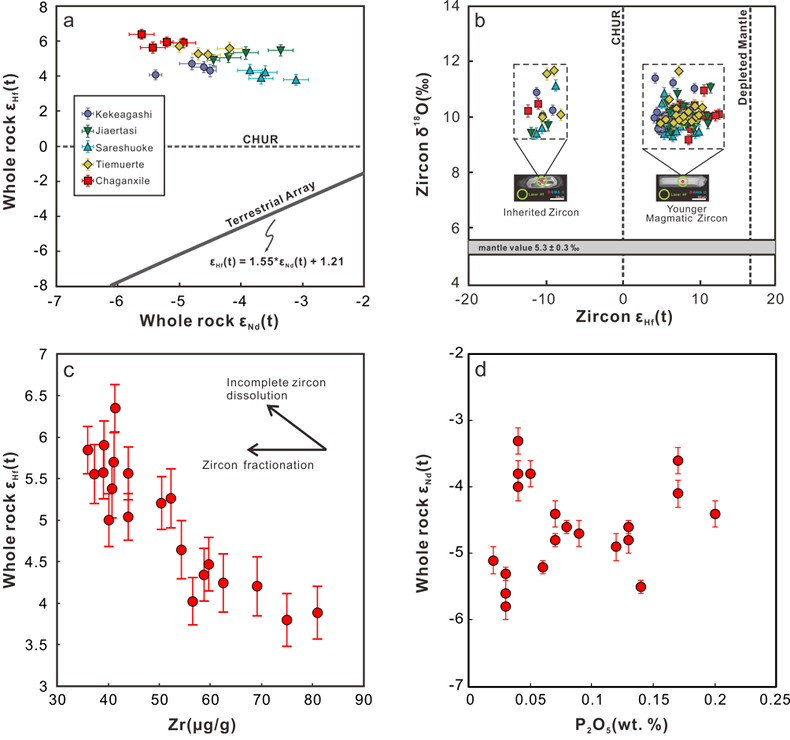
Figure 1 (a) εHf(t) versus εNd(t) for SPG in the Chinese Altai calculated based on U-Pb ages of the various plutons. Terrestrial array equations are from Vervoort et al. (2011)
Vervoort, J.D., Plank, T., Prytulak, J. (2011) The Hf–Nd isotopic composition of marine sediments. Geochimica et Cosmochimica Acta 75, 5903–5926.
. (b) Zircon εHf(t) versus zircon δ18O for SPG in the Chinese Altai. Mantle values after Valley et al. (1998)Valley, J.W., Kinny, P.D., Schulze, D.J., Spicuzza, M.J. (1998) Zircon megacrysts from kimberlite: oxygen isotope variability among mantle melts. Contributions to Mineralogy and Petrology 133, 1–11.
. Inherited zircons show εHf(t) and δ18O values, indicating a metasedimentary source. Younger magmatic zircons show positive εHf(t) values and similarly high δ18O values, CHUR-chondritic uniform reservoir. (c) εHf(t) versus Zr (µg/g). (d) εNd(t) versus P2O5 (wt. %). Uncertainties of all isotope measurements are internal 2σ.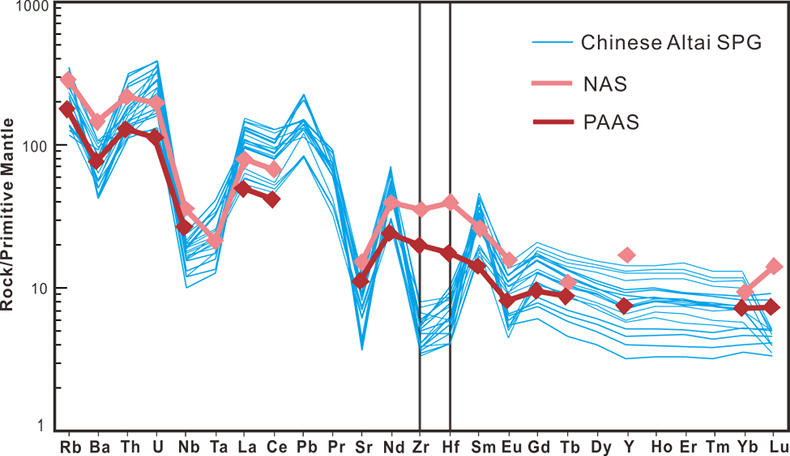
Figure 2 Primitive mantle-normalised trace element spider patterns of the studied granites, PAAS and NAS. Normalisation data from Sun and McDonough (1989)
Sun, S.S., McDonough, W.F. (1989) Chemical and isotopic systematics of oceanic basalts: implications for mantle composition and processes. Geological Society, London, Special Publications, 42, 313-345.
. Note the Zr-Hf depletions of the SPG from this study. All the data are listed in Table S-4.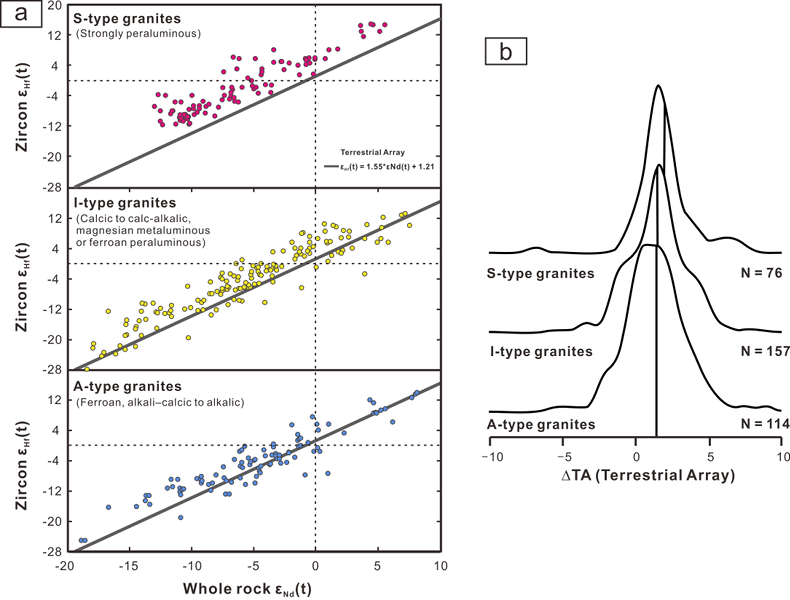
Figure 3 (a) Compilation of published neodymium and hafnium isotopic compositions of I-type, A-type, and S-type granites (as defined in the figure). Points represent average zircon values from single plutons. References listed in Table S-3. (b) Distance from the terrestrial array (TA) expressed as ΔTA calculated for the three granite groups. Vertical line represents the median of all of the samples and demonstrate an increasing shift towards greater Hf disequilibrium (above the TA) with increasing aluminousity.
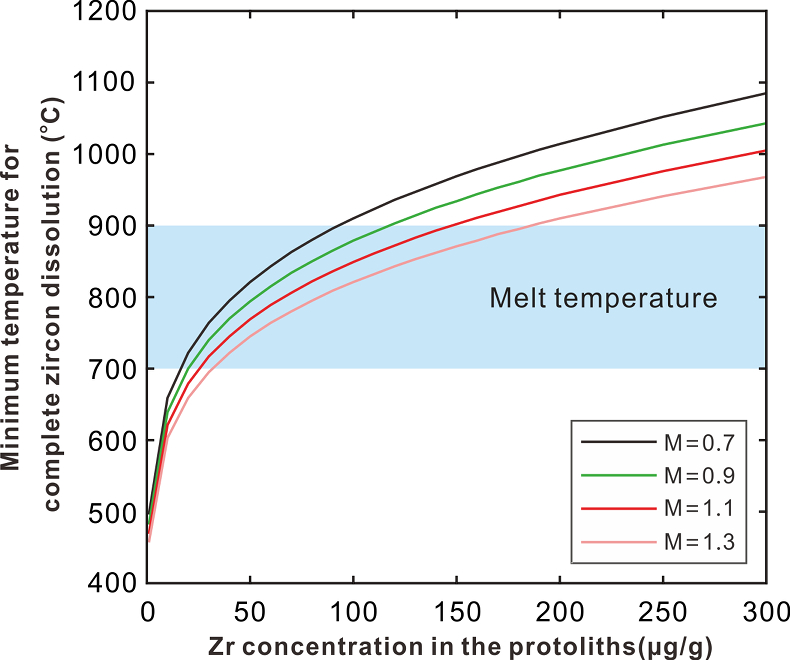
Figure 4 Calculated minimum melt temperature for zircon dissolution as a function of Zr concentration in the protoliths and M value (cation ratio). SPG have M values > 1.1 while I-type granites typically have M values < 1.0. Melt Zr concentration at zircon saturation using the zircon saturation model of Boehnke et al. (2013)
Boehnke, P., Watson, E.B., Trail, D., Harrison, T.M., Schmitt, A.K. (2013) Zircon saturation re-revisited. Chemical Geology 351, 324–334.
.





